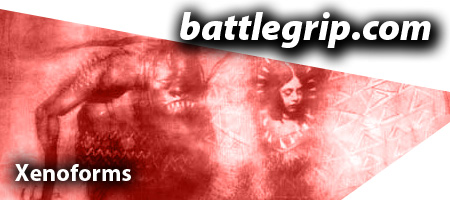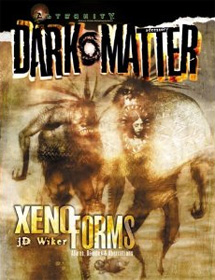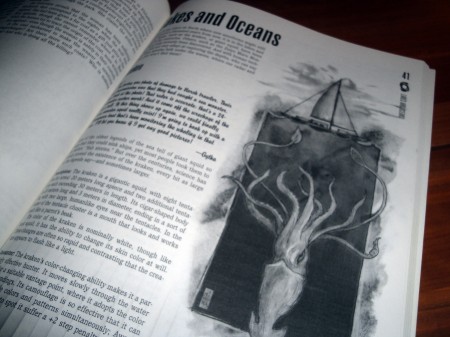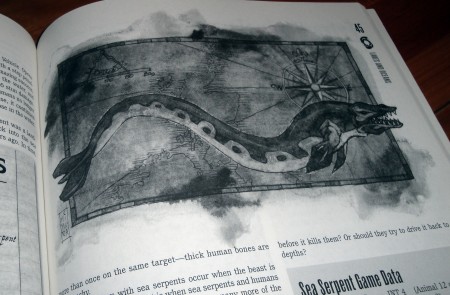Reading – Xenoforms, A Dark*Matter Supplement

NOTE: I wrote this review over a decade ago. It has been transported to battlegrip.com to keep it safe for the future.
The first thing you notice about Xenoforms*, the last printed Dark*Matter (Amazon.com search*) supplement, (when you finish drooling over the beautiful Ashley Wood cover) is the lack of any extra colors over the typical black and white found in most game books. The paper also feels like a cheaper stock which is disappointing considering the high production qualities of earlier books in the series.
Fortunately, the contents are still (usually) high-quality.

Subtitled “Aliens, Demons & Aberrations,” Xenoforms* presents almost fifty bizarre creatures and aliens from the Dark*Matter campaign world. Each is well detailed and illustrated with specific game statistics a minor portion of the book. One of the better features of each creature is the “adventure hook” that is usually 2 or 3 paragraphs in length and presents the game master with one idea of how to use the creature in his campaign. This is a very appreciated feature!
The creatures are broken down by general type and location into eleven sections.
- Africa – A disappointing chapter that details only two creatures. While the creatures presented (the Congoraptor and Flying Snake) are very well-written and detailed beasties, the failure to take advantage of the rich and varied cryptozoological myths surrounding Africa is almost unacceptable. The book titled Cryptozoology for Conspiracy X is a much better choice for game masters looking to run adventures in Africa. The Dark*Mattercore book gives a better treatment of Africa than this chapter does.
- North America – It’s upon completion of this chapter that I checked the contents page and discovered that the number of creatures detailed in each chapter is a pretty dismal number in most instances. Oh well. North America has three creatures, none of which are especially interesting.

- Central and South America –This chapter will forever live in my mind as the home of Raven Mimura’s beautiful illustration of El Chupacabras, the goatsucker. The fact that the monster’s description is as good as the artwork really helps the usefulness of this chapter. If your modern day conspiracy campaign is headed for this area of the world you owe it to yourself to consider throwing this beauty into the game. (Or, if you’re really mean, throw one of these at them when they’re in an urban locale and watch them go crazy trying to figure out how the beast made it into a large city.)
- Asia –The Ikuya (a giant bear that may very well be a god), Naga (an intelligent serpent), and the Reiko (a Japanese animal spirit) are the three creatures that comprise this chapter. None of them excited me all that much.
- Australia –Of the two creatures in this chapter, the outback dragon is the more exciting one.
- Europe/Near East – Finally, a chapter with some meat! This chapter has six creatures (though I have a tough time with their being two different werewolf entries) and some of the better adventure hooks in the book. A fairly detailed treatment on lycanthropy helps to bulk up this chapter with some valuable material for Dark*Matter (Amazon.com search*) games (though the specific game statistics are far less useful to GMs who are using this book with other game systems).
- Lakes and Oceans – I’ve long been fascinated with sea monsters and found this chapter adequate though far better than the Africa chapter. Game masters wishing to use sea monsters in their games shouldn’t expect too much from this chapter.

- Extradimensionals –The longest chapter in the book, Extradimensionals details eleven beings that while they are on our world, each is from a very different reality. “Suppressed Transmission” readers will enjoy the Blood Devil simply for its attempt to classify and quantify “Spring-Heeled Jack.” The revenant and shade are both very well done though the lack of an adventure hook for the revenant is upsetting.
- Extraphysicals –A very good chapter and the second longest in the book. Of the nine creatures presented in this chapter the golem is easily my favorite (simply for the superb adventure hook which includes the questioning line “Can the heroes defeat the combined power of a Freemason sorcerer and a rogue golem?” If the book had included more adventure hooks like this it would have become the best purchase of the year.
- Extratemporals –Described in the book as ” . . . xenoforms that have managed to survive the extinction of their species . . . ” the two dinosaurian creatures and the Neanderthal all help to make up for the poor showing of the Africa chapter. Why exactly they were chosen to comprise a chapter of their own is something I’ll never understand but their appearance here does make me significantly happier with the overall value of the book.
- Extraterrestrials – Even though the Dark*Matter (Amazon.com search*) rulebook has short description of the Grey, Ekimmu, and Kinori alien races I had hoped for in-depth treatment of these races here. Instead we’re presented with 3 new (and fairly useless to me) alien races. To make matters worse the “Starchild” doesn’t even include an adventure hook.
While certainly not the ultimate source on cryptozoology for gamers (that title is yet to be earned by any game book), Xenoforms* is a well-written, (mostly) enjoyable product and a must have for any Dark*Matter game master. In addition, game masters running any type of conspiracy or modern horror game (such as Conspiracy X, Over the Edge, Delta Green, or GURPS Black Ops) may find the book of some help in populating their campaign worlds with even more beasties for the players to try and beat on or capture. Be sure to flip through the book and give it a close look in the store before taking it home.
Related articles
- Reading – Old World Bestiary (battlegrip.com)
- Dark Horse Uncovers “The Legend of Zelda: Hyrule Historia” (comicbookresources.com)
- Supplement Review: Mysteries of the Dead Side: Sacred Necromancer (PFRPG) from Zombie Sky Press (gameknightreviews.com)
